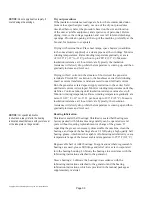
Page 34
Copyright © 2012 Kato Engineering, Inc. All rights reserved
Use multiple sprays with clean water to remove or dilute the detergent
following the detergent spray. Dry the machine until acceptable
insulation resistance values are obtained at room
temperature. See the insulation resistance procedures below for minimum
recommended values.
Electrical contacts: Clean electrical contacts, switch contacts and
terminals with an approved contact cleaner. Do not fi le contacts.
Insulation resistance tests at low voltage
Insulation tests are conducted for two reasons: to discern existing
weakness or faults or to give some indication of expected service
reliability.
Insulation resistance tests are based on determining the current
through the insulation and across the surface when a DC voltage is
applied. The leakage current is dependent upon the voltage and time of
application, the area and thickness of the insulation, and the temperature
and humidity conditions during the test.
Refer to the following electrical measurement procedures for testing
detail. Contact Kato Engineering or refer to IEEE Standard. 432-1992
when more extensive insulation tests are required
When checking insulation resistance with a megger, fi rst verify the
ground path. Connect one test lead to a ground point. Then connect
the second test lead to another ground location to prove the ground
connection. Once the ground path has been proven, the second test lead
can be connected to the leads of the component to be tested.
Exciter fi eld (stator) and PMG armature (stator)
1. Disconnect the exciter leads from the terminals in the ter minal box or
the voltage regulator.
2. Connect exciter leads to one clamp of 500-volt megger, and connect
the other clamp to the exciter fi eld frame.
3. Apply 500 V from the megger, and measure the resistance reading
after 1 minute. The reading must be a minimum of 50 megohm. If it
is not, refer to the cleaning or dry out procedures.
4. Ground the exciter fi eld leads to the exciter fi eld frame for several
minutes after the megger has been disconnected. This will allow the
voltage build up to be properly discharged.
5. Repeat steps 1-4 for the PMG armature (stator).
IMPORTANT: The insulation resistance
tests are usually made on all or parts
of an armature or fi eld circuit to ground.
They primarily indicate the degree of
contamination of the insulating surfaces
or solid insulation by moisture and other
conducting infl uences and will not usually
reveal complete or uncontaminated
ruptures.
IMPORTANT: The insulation resistance
value increases with de creasing winding
temperatures. All readings must be
corrected to winding temperatures. Use
Table 4 for converting megger readings to
other temperatures (e.g., 100 megohms at
50º C is converted to 170 megohms: 1.7 x
100).
T
able 4: Temperature conversion
factor for resistance readings
Winding
Temp
(ºC)
0.23
0.37
0.6
1
1.7
2.7
4.5
7.5
14
23
38
61
Conversion
factor
10
20
30
40
50
60
70
80
90
100
110
120
NOTICE: Never apply the megger to the
rotating rectifi er, the voltage regulator, or
generator accessories (e.g., temperature
detectors, space heaters) These devices
can be damaged by the applied voltage.
IMPORTANT: New generators should
measure about 100 megohms minimum
of insulation resistance when meggered.
Generators that read 50 megohms or less
should be dried out according to the dry out
procedures here. Generators with insulation
resistance readings of 10 megohms or less
should be investigated.
















































